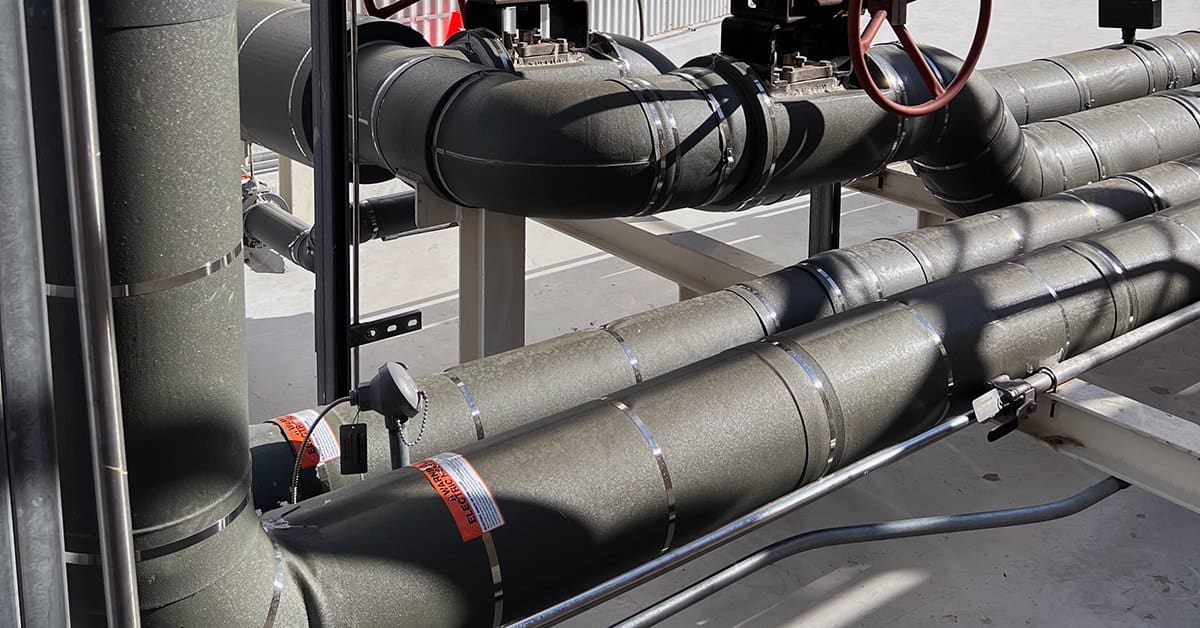Industrial Insulation Can Either Protect Your Pipes and Tanks, Or It Can Ruin Them. So It Pays to Know as Much as Possible About Your Investment.
Insulating industrial pipelines, tanks and accompanying equipment is tricky business. Choose the right materials, and you can have years of worry-free protection. Choose the wrong materials, and you can have years of mediocre functionality, difficult maintenance and the potential for corroded systems.
As the maker of next-gen, fully encapsulated industrial insulation solutions, Dragon Jacket Insulation solves problems that are simply beyond the scope of traditional insulation systems. To really understand the difference, side-by-side comparisons are helpful.
DRAGON JACKET VS FIBERGLASS, ROCKWOOL & CALCIUM SILICATE
Water Permeability
What to look for – Waterproof, chemical-resistant materials that don’t contribute to CUI.
Whether it’s from operational condensation or a passing storm, when it comes to functionality, water can be insulation’s Achilles heel. As the culprit behind expensive and often dangerous corrosion under insulation (CUI), and the reason insulation fails to deliver on promised R-values, the impact of water on a system is no joke.

Because of the damage water can do to a system, the permeability or impermeability of insulation should be one of the first things you think about when starting a new project or replacing old insulation. While standard insulation options are like sponges, Dragon Jacket’s closed-cell foam core is chemical resistant and does not retain water – at all. In the event of a leak, the small opening along the insulation’s drip edge allows for moisture to escape without pulling heat away from the operating system or requiring the need to fully remove and replace the insulation.
Watch this video to see how it works
R-Value & Heat Transfer
What to look for – Consistency across temperatures.
The whole point of insulation is to keep tank and pipeline contents at their required temperatures. In order to accomplish this, the insulation needs to mitigate heat transfer by having a high enough R-value to keep the heat in the pipes from escaping.
The problem with most insulation types is that their R-value decreases relative to pipeline temperature increases. That’s why, especially when working with higher temperatures, it’s imperative to find insulation with an R-value that is consistent despite temperature increases.
(And don’t forget, as soon as those other insulation types get wet…their R-value goes right out the window.)

Dragon Jacket’s R-value stays consistent across temperatures to ensure minimal to no heat transfer for more efficient operations. And one-inch-thick Dragon Jacket Insulation has an equivalent R-value of two inches of standard insulation, making it a preferred option for tight spaces.


Installation & Maintenance
What to look for – Fast installation using standard tools.
Some jobs are just a pain, and for decades, installing insulation was one of them. Traditional insulation is hard to work with – it doesn’t stay in place, it requires a second layer of cladding and it often requires special tools, skills and multiple people. And what do you get for all that hassle, expense, and frustration? A product that is merely adequate as long as it never gets wet.
Dragon Jacket changed all that. It performs as intended, is super easy to install using standard tools and personnel, and it’s a one-and-done solution that requires no additional cladding.
See for yourself!
Durability
What to look for – Insulation that Stands up to Wear and Tear.
It will take just one hailstorm or a dropped tool to damage the aluminum cladding needed to protect traditional insulation. Why is this? Because traditional insulation is delicate. But managing an industrial operation is not a delicate business. From harsh weather to freezing temperatures to chemicals and removal and reinstallation, insulation needs to be tough enough to stand up to the day-to-day stresses that come with the job.
That’s why we engineered Dragon Jacket to be able to take a hit, and then some. Go ahead and drop it, stomp it, blast it with a power washer, douse it with chemicals, leave it out in the rain – run it over with a truck. Dragon Jacket will stand up to just about whatever you can throw at it.




